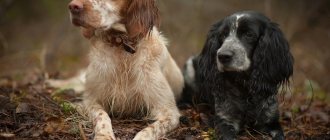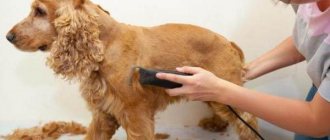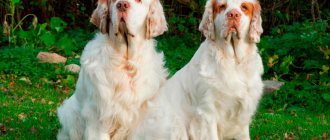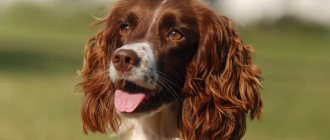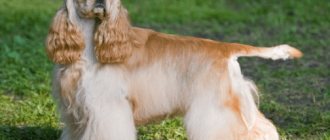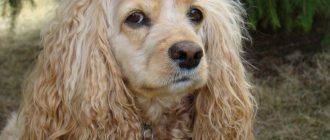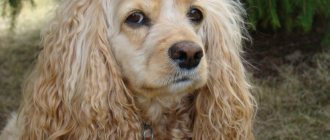In your opinion, the ideal companion dog is a lively, light, graceful creature, moderately curious and certainly smart?
Requiring minimal care, feeling comfortable even in a small apartment, loving to bask on pillows, but always ready to play and frolic, ready for both long walks and sometimes doing without them at all?
The continental toy spaniel, or papillon, as the breed is most often called, fits this description perfectly. Miniature sizes are combined with endurance and good health, an unusual, spectacular appearance - with very modest care needs. A special feature of the breed (besides the magnificent ears covered with long wavy hair) is its outstanding intelligence. In the ranking of the “smartest” breeds, Papillons rightfully belong to eighth place!
History of the origin of the breed
The official name of the breed, Continental Toy Spaniel, is rarely used; more often the dogs are called Papillons and Phalenes. The first are animals with erect ears, similar to the wings of a butterfly (this word is translated from French and pronounced as “Papillon” - sometimes the breed is called that). Phalenes are continental toy spaniels with floppy ears. There is no consensus on the time of origin of the breed. On the one hand, it is believed that the breed was formed in the 14th century. On the other hand, there is evidence that back in 1099, Duke of Lower Lorraine Gottfried brought tiny “moth” dogs from the crusade to Jerusalem.
The history of mankind is inextricably linked with the history of the development of dogs. For a long time, dogs have been our partners. When humanity experienced the transition from the nomadic life of hunters to the sedentary life, dogs appeared, herding herds of goats, sheep and cattle. Guard dogs have protected people for a long time, from the beginning of cultural existence to the present time.
But the intertwined stories of humanity and dogs did not stop with the emergence of working dogs. Even 200 years ago, in the temples of Tibet, dogs were revered as a deity, they inspired monks. 1000 years ago in Europe it was considered good manners to keep small dogs in royal courts. Humanity, apparently, needs lap dogs just as much as it needs guards, shepherds, etc.
The Papillon that found its way into our city apartments has a rich and regal family history. It is a historical fact that the Papillon's ancestors were favorites at royal courts.
The Papillon (“Papillon” is how the word is pronounced in the French manner) is a descendant of the Continental Spaniel. This breed originated in the 14th century. Belgium and France are supposedly considered to be the birthplace of Papillons, hence the name “Papillon” (“butterfly” translated from French) and “phalen” (moth) for the fold-eared variety.
A notable feature of the breed is its beautiful, butterfly-wing-like ears.
This dog was a favorite of royalty and nobility.
The history of the breed is closely connected with the history of France. King Henry III was accused of ruining the royal treasury; he spent public money on purchasing tiny spaniels. Henry often visited Leon, where “butterflies” were bred and, according to historians, in 1576 he spent more than 100,000 crowns on dogs. “Butterflies” accompanied Henry III everywhere: to receptions, state councils, sitting comfortably in a basket hanging on the king’s chest. Henry ordered dresses with numerous pockets for his dogs. The king had 3 favorites who had access to the royal bed. One of these dogs was named Lilin. And it was she who was with the king in San Cloud, where a monk named Clemen asked for an audience. Lilin expressed her dislike for the monk with a loud bark. The dog had to be removed from the reception hall to the lobby. Left alone with the king, the monk pierced his chest with a dagger. The dog raised the alarm, the killer was detained, but this did not save the Valois descendant... Dying, the king whispered: “Oh, if only I had listened to my Lilin...”
Papillons were also owned by Henry the Fourth, Louis the Thirteenth, Louis the Fourteenth, Marie Antoinette, Madame de Pompadour, Queen Sophie Dorothea of Prussia.
Interesting Facts
France is the birthplace of the Phalenes.
There are several interesting facts about the Phalenes:
- representatives of the breed have an excellent sense of smell;
- Phalenes are the most famous breed in France;
- in the Middle Ages, such dogs were popular among the French nobility.
Phalene is a fairly well-known breed that is popular among dog breeders. Caring for such a dog is quite simple. However, despite this, people who decide to get such dogs should familiarize themselves with the features of caring for them.
Description of the breed
The current breed standard was approved by the FCI in 1998. The Continental Toy Spaniel is a luxurious miniature dog with strong yet graceful bones and elegant, effortless movements. Papillons have a cheerful character and lively temperament. The height of the dogs is about 28 cm, and the standard provides two weight categories: males and females weighing from 1.5 to 2.5 kg, and males and females weighing 2.5 to 5 kg.
- The Papillon's head is proportional to the body, the skull is not too rounded, and sometimes a groove in the middle is slightly noticeable. The transition from forehead to muzzle is quite pronounced. In larger dogs it is more noticeable; in small dogs it does not have a sharp ledge. The muzzle is shorter than the skull, graceful, but not pointed and not upturned, not sunken at the sides.
- The ears are thin, but strong. The standard provides for two varieties: phalen (dropping ears) and paillon (erect ears). Both varieties should not have a sharp tip (determined by hand). The ears are set close to the back of the head, quite wide.
- Drop ears (phalen). Set noticeably above eye level, hanging down freely, but at the same time mobile. The decorative coat is quite long and wavy. It gives the dog a cute, cuddly appearance.
- Prick ears (Papillon). Set high, well open. The angle between the horizontal and the inner edge of the auricle is approximately 45°. The ear should not stand upright like a Spitz's. Fine hairs grow on the inner surface of the ear, some of them protrude slightly beyond the edge of the ear. The outside of the ears is covered with long hair, forming a fringe that extends beyond the edges of the ear. When crossing two varieties of dogs, animals with semi-erect ears appear, and this is a serious disadvantage.
- The eyes are expressive, almond-shaped, fairly large, not protruding, but well open. Set low: the inner corners of the eyes are in line with the junction of the muzzle and skull. Eye color is dark, eyelids are pigmented.
- The Papillon's nose is straight, the nose is rounded, small, and somewhat flattened on top. The color of the earlobe is black.
- Dogs have an even, normal bite, their teeth and jaws are strong. The lips are thin, tightly fitting, highly pigmented. The tongue should not protrude from the mouth. If it is constantly visible and cannot be removed when touched with a finger, this is considered a flaw.
- The dog's body is harmoniously built, somewhat elongated. The abdomen is moderately tucked.
- The chest is wide and low, the ribs are well sprung. The chest circumference is ideally equal to the approximate height at the withers.
- The back of the Continental Toy Spaniel breed is not sagging or flat.
- The Papillon's forelimbs are strong, straight, and not too long. Placed in parallel. Elbows pressed to the body. The paws are long, “hare-shaped”, the toes are mobile, resting on durable pads. The claws are strong, most often dark. Light and white nails are acceptable in dogs of white-sable or predominantly white color. Long hair grows between the toes, forming a plume.
- The hind legs of the Papillon are distinguished by good articulation angles. The paws are the same as the front ones: “hare-like”, with movable toes, strong claws and hair that forms a plume.
- The tail is set relatively high and quite long. The decorative fur is abundant and forms a luxurious dewlap. When moving, the dog keeps its tail raised along the line of the back and bends it. The tip of the tail can only touch the back; the tail should not be curled or lie on the back.
- The Continental Toy Spaniel's coat has no undercoat. It is long, wavy and shiny. Soft, but at the same time elastic to the touch. The fur is thin and fits tightly to the dog's body. The coat should not resemble that of a Spitz. The hair is short around the eyes, on the muzzle and on the front of the legs. On the body the hair is of moderate length; on the neck it lengthens, forming a collar. The coat flows in waves onto the chest, forms lush feathering on the back of the forelimbs and ears, and luxurious “pants” on the back of the thighs. The length of the fur on the tail can reach 15 cm.
We advise you to read: Bichon Frize Dog Breed
The color can be any color, taking into account that the shirt must be white. On the body and legs, white should predominate over the colored areas. White color on the head is preferable in the form of a more or less wide star. A white marking on the underside (front) of the head is acceptable, but a predominant white color on the head is a fault.
Advantages and disadvantages
Attractive appearance is one of the advantages of the
Phalen breed, like all other dog breeds, it has a number of advantages and disadvantages. The main advantages include the following:
- high level of intelligence and quick learning ability;
- kindness;
- loyalty;
- unusual appearance;
- ease of maintenance at home.
Among the disadvantages are:
- frequent barking for no reason;
- cunning;
- Difficulty caring for long hair.
Character of Phalen
A sociable, lively, inquisitive dog with a spectacular appearance is one of the best candidates for the role of an ideal companion. Papillons love walks, but can do without them if the owner does not like to get up early in the morning and go out late in the evening.
The disadvantages of the breed are conditional; they are a direct continuation of its advantages. Papillons vitally need communication with their owners. They may well be alone for a few hours, but daily prolonged loneliness causes them real suffering. They will also be uncomfortable in the company of unceremonious children who tend to see a small dog as a living toy.
If you are sure that you will find time for your future pet, then he will respond to you with the most sincere affection. They are not destructive by nature, so you don’t have to worry that they will start “redoing” the design of your home to their taste.
Papillons are very loyal dogs to their owners, with a lively and cheerful temperament. You might think that Papillons are classic lap dogs that mostly sit on their owner’s lap and watch the world around them. But that's not true. Papillons are very energetic dogs and even love to hunt butterflies, moths, mice and other small creatures if given the opportunity.
Puppies of this dog breed need very early socialization, before they open their eyes. This is due to the tendency of these dogs to bite when they are afraid. With responsible breeding and proper rearing, this breed disadvantage can be overcome. Puppies need to develop a calm and trusting character. If you raise a Papillon puppy correctly, he will be quite curious, but at the same time calm. He will not be very afraid and react sharply to everything new.
We advise you to read: Breeds of medium-sized dogs
They are also intelligent, easy to train and submissive.
Papillons are extremely athletic dogs. They are fascinated by fast-paced games, running, and jumping. They love long walks, especially in the company of their owner.
Diet
Meat is the main component of a dog’s diet.
The diet of falens should consist of two-thirds meat products and one-third plant foods. The dog should be fed the following foods daily:
- meat (lean);
- bran;
- bones;
- vegetables;
- fish;
- porridge;
- vitamin supplements.
Phalena should be fed three times a day. At the same time, large portions should not be given so that the pet does not overeat.
Caring for Phalen
Despite their impressive appearance, Papillons are called “a dog for the lazy.” Of course, if you plan to conquer the podiums of exhibitions, the dog will require special care. But in ordinary life, the Papillon does not need trimming; it is enough to comb your pet regularly. You need to bathe your dog as needed. Dogs with floppy ears need regular ear examinations.
Continental Toy Spaniels do not need to be walked; they quickly learn to use a litter box. However, to maintain good shape, walking is necessary, do not forget about it.
Papillons' coat care is different from most other dogs' coats. However, do not think that caring for these dogs is too difficult. It is enough to brush your Papillon just twice a week and his coat will always be in good condition. During shedding, it is recommended to increase the frequency of brushing. Papillons shed twice a year.
To bathe this breed of dog, you need to choose a shampoo that will not leave a yellow tint on the Papillon's coat. Many dog breeders use human shampoos for platinum blondes or gray hair. After using shampoo, it is important to thoroughly rinse the Papillon's coat with water, otherwise the remaining shampoo can also cause the appearance of a tint on the dog's coat.
If the Papillon coat is in good condition, then it does not need additional moisturizing and the use of creams. However, a small amount of cream can be used on red and black Papillons and will not harm their coat as their coats tend to be a little drier than other colored Papillons.
Professional groomers note that when using the cream, Papillons of other colors tend to have coats that look greasy and unkempt. It is recommended that the fur on the belly and around the paw pads of Papillons be cut for hygienic reasons. It is also necessary to periodically check the ears of Papillons, they must be clean and dry.
Papillons also need to regularly brush their teeth and trim their nails.
Despite their small size, Papillons are energetic dogs and need plenty of exercise. Daily walks with these dogs are important to keep Papillons in good physical condition.
Don't forget, Papillons need regular attention and communication, without it they become very irritable.
Eyes are the mirror of the soul. To maintain the Papillon's eyes and fur around the eye sockets in perfect condition, hygiene procedures should be carried out every three days.
If a small amount of secretion accumulates in the corners of the eye, after sleep you need to carefully remove the accumulated mucus with a cotton pad soaked in eye care product (or simply boiled water). Each eye is treated with a separate clean cotton pad. If there is little mucus and it appears only in the morning, the Papillon’s eyes are not red, then there is nothing particularly to worry about. If purulent discharge appears or the eyes turn red, you should consult a veterinarian.
We advise you to read: South African Boerboel Dog Breed
Quite often, Papillons suffer from watery eyes.
There can be several causes of lacrimation in dogs: inflammation of the lacrimal sac, blockage of the tear ducts, inversion of eyelashes or eyelids, an extra row of eyelashes, too thick eyelashes in the corners of the eye, or a foreign object getting into the eye. In these cases, only the intervention of a veterinarian will help.
But often the Papillon’s eyes run due to the high content of protein or carbohydrates in the diet; this could be a reaction to the wind with particles of dust and sand, a reaction to melted spring snow, or an allergic reaction to various aerosols being sprayed near the dog.
If you find out that lacrimation is a reaction to dry food, which may well be the case, you should gradually switch your dog to another brand of super premium dry food.
The consequence of lacrimation is tear tracks, which are especially noticeable in Papillons with white hair on the face. Hair wet from tears under the eyes is a favorable environment for the development of bacteria; red-brown smudges and even ulcers appear in places where moisture accumulates. Be careful and don't let this happen!
It is extremely difficult to get rid of tear tracks and only daily systematic care of the eyes and the hair around the eyes will help.
Toilet
Despite their good memory and remarkable intelligence, puppies cannot immediately figure out the toilet. To help them with this difficult task, cover a large area with diapers to begin with. Then gradually reduce their number. If you see that the puppy begins to spin around and sit down in a place other than where he is supposed to, do not swear, but take him to the diaper. When your little friend does his “things” right, be sure to praise him. This is necessary to quickly consolidate the skill.
Phalen training
There are no working tests for this breed - miniature dogs become exclusively companions. Their developed intelligence allows them to quickly learn all the commands and rules of behavior necessary for a well-mannered dog, and their tirelessness and liveliness of character provide continental toy spaniels with good results in agility.
Strictly speaking, agility is just one of the disciplines included in dog competitions for passing a course with obstacles at speed. In addition to agility itself, there are also jumping, gambler, snooker and relay races.
Of course, the word that is closest to understanding for the average dog breeder is relay race. A dog relay race is exactly what you think it is: teams of pets and owners, united according to a club or any other principle, compete with each other in cleanliness and speed in completing a distance with obstacles. Of course, the previous “dog-owner” pair passes the baton to the next one.
The next, more or less understandable word is jumping. It hides behind itself a rather spectacular and dynamic competitive discipline. Its peculiarity is that the dog must cover a distance consisting of non-contact obstacles. Actually, the name “jumping” means that most of the projectiles need to be jumped over. Jumping, like agility, are the key disciplines in which the overall winner is determined at competitions.
For creative and inspired athletes, a special type of obstacle course has been invented - gambler. In this case, the dog is required not only to give physical performance according to the principle “faster, higher, stronger,” but also to be able to understand the owner and his tasks perfectly. Gambling is the ability to build a winning strategy. It is not necessary to go through all the obstacles without exception in a certain order. You can win by excluding a number of projectiles from your route, or by going through them cleanly and all in the sequence in which it is beneficial for the dog. One way or another, the human-dog sports couple must score a certain number of points in a given time. At the same time, it is prohibited to undergo the same test twice, and each of the shells has its own “price”. The passage of the route should look consistent, not spontaneous.
How to choose a puppy
The main rule for choosing a good puppy is that you need to purchase it from specialized nurseries or from trusted, reputable breeders. Buying a puppy from private hands is a blind purchase. Conscientious breeders sell puppies with their first vaccinations, with a veterinary passport, and with a puppy card. Such sellers give recommendations on feeding and raising the puppy, accompany the owner in the future, and help find partners for future breeding.
In each litter from parents with good pedigree, the owners divide the puppies into three categories. Pet class is suitable for use only as a pet; such puppies have a slight breed defect (disqualifying sign: inappropriate color, crease in tail, malocclusion, etc.). Pet puppies are excluded from further breeding; they are cheaper than others. The breed class meets all breed standards and is suitable for breeding and exhibition career.
The price is average. Show class is assigned to puppies with excellent exterior characteristics. These dogs have a career prospect at international exhibitions, they are capable of becoming excellent producers, therefore they are more expensive than others. You need to purchase a puppy in accordance with your goals and financial capabilities.
In conclusion, we can say that Continental Toy Spaniels are popular for several reasons: they are small in stature, look charming, have developed intelligence, are completely people-oriented, and have good health. Such dogs become full-fledged members of the family, delighting their owners.
Phalen's Health
Miniature size does not prevent the breed from having good health. There are diseases that Papillons are genetically predisposed to, such as luxating patellas or deafness, but if you choose a puppy from a good kennel, these most likely won't bother you. Remember that small dogs are quite fragile creatures when they are puppies, and be extremely careful at home so as not to injure them.
The most common diseases in this dog breed are:
- Entropy (turn of the century)
- Cataract
- Corneal dystrophy
- Congenital deafness
Theses
- Although not typical for the breed, some lines may be timid, aggressive, or shy. This is the result of uncontrolled breeding at the peak of the breed's popularity.
- Not suitable for those who do not have time for their dog.
- Puppies are very fragile and can be injured by rough or careless handling. It is better not to have these dogs in families with young children.
- These dogs are sensitive to anesthesia, which is something to keep in mind when visiting your veterinarian.
- These are highly energetic dogs that require more than a leisurely stroll around the house.
- They are aggressive towards other animals and can even kill small ones.
- Some are also aggressive towards other dogs and will fight with any opponent.
Photos of Phalena
Mating
To get Phalene puppies, you will have to start breeding dogs. This should be done following the following recommendations:
- for mating they use animals that have already completed puberty (from 1.5 years);
- the dogs chosen for mating should not be sick;
- it is important that mating is not carried out more than once a year;
- It is advisable to engage in mating on the third or fourth day of estrus in females.
Important! Mating must be carried out without human intervention. However, if necessary, you can hold the female.
Content Features
Due to its small size and calm disposition, phalen is perfect for keeping even in a small apartment. In addition, it is not destructive; puppies can be brought into an interior with expensive furniture without fear. Phalen will calmly wait for the owner from work, but is not suitable for families where there is no one at home for days on end, it languishes without attention and can acquire bad habits.
The undoubted advantage of phalen is that it is as energetic as the owner requires. With an active person, he will be happy to walk in nature or prepare for competitions. The most suitable disciplines: agility, flyball, freestyle. Those who lead a moderate lifestyle will be content with short walks. In cold weather or bad weather, he can easily sit at home for a day or two if he has been accustomed to wearing a diaper. It tolerates various temperatures well and does not require insulation with clothes in frosts down to -15°C.


